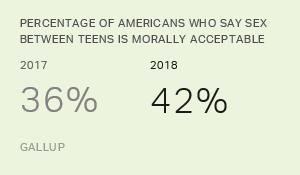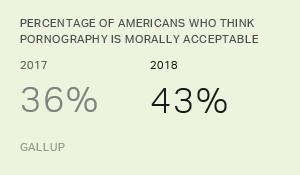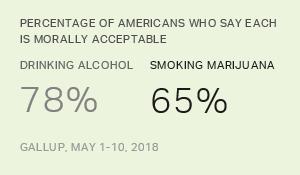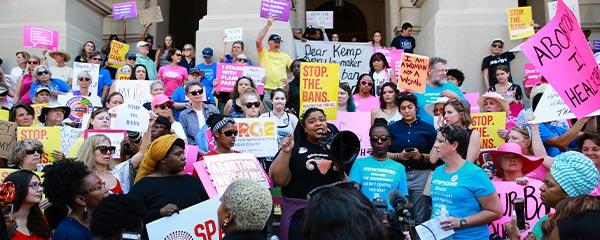Story Highlights
- 48% identify as pro-choice, 48% as pro-life
- Half continue to say abortion should be legal in some circumstances
- Slightly more say it is morally wrong than morally acceptable
This story is part of a special series on Americans' attitudes toward abortion in 2018.
WASHINGTON, D.C. -- Americans' views on the abortion issue continue to be closely divided. Currently, as many Americans personally identify as "pro-choice" on the issue as say they are "pro-life."

The latest results were measured May 1-10 in Â鶹´«Ã½AV's annual Values and Beliefs poll. They come as the issue has received renewed attention at the state level, with Iowa recently passing a restrictive law that bans nearly all abortions once a doctor can detect a fetal heartbeat, which commonly occurs early in a pregnancy. A legal challenge to that law has put its planned July 1 implementation on hold. The U.S. Supreme Court also recently allowed an Arkansas ban on abortion pills to stand.
Although there has been some variation in past years, Americans have typically been closely split on whether they consider themselves pro-choice or pro-life, particularly since 2000, when the averages have been 47% pro-choice and 46% pro-life. During the 1990s -- when Â鶹´«Ã½AV first asked the question -- more Americans personally identified as pro-choice than as pro-life by 51% to 40%, on average.
Most Do Not Favor Outright Ban, but Want Limits on Abortions
When asked more specifically about their views on the legality of abortion, half of Americans adopt a middle-of-the-road position, saying abortion should be legal "only under certain circumstances." Americans with more absolute positions tend to come down on the side of abortion being legal under any circumstances (29%) than being illegal in all circumstances (18%).
Historically, Americans have been most likely to favor the middle position -- abortion being legal under certain circumstances. Rarely has the percentage saying abortion should sometimes be legal fallen below 50%, averaging 53% since it was first asked in 1975.
There has been a slight uptick in the percentage saying abortion should always be legal, from 21% in 1975 -- two years after the Roe v. Wade decision legalized abortion nationwide -- to 29% today. This percentage has varied in the interim, peaking at 33% in 1991, 1994 and 1995, but reverting to 21% as recently as 2009, and averaging 27%.
In the 1975 poll, 22% of Americans said abortion should be illegal in all circumstances. The 18% who currently hold this view matches the average over the past 43 years.

Although close to eight in 10 Americans believe abortion should be legal in all or some circumstances, further probing of their attitudes finds the public favoring more restrictive rather than less restrictive laws. In a follow-up question asked of those in the middle "legal under certain circumstances" group, most of these respondents say it should be legal "only in a few" rather than in "most" circumstances.
The result is that 43% of Americans say abortion should be legal in all (29%) or most (14%) circumstances, while a majority of 53% say it should be legal in only a few (35%) or no circumstances (18%). No fewer than 51% of Americans have favored more restrictive abortion laws since 1994, when Â鶹´«Ã½AV first asked the follow-up probe of those saying abortion should be legal under certain circumstances.
Slightly More Americans Regard Abortion as Morally Wrong Than as Acceptable
A separate question in the survey asks Americans whether abortion, along with 22 other behaviors and practices, is morally acceptable or morally wrong. By a slim five-percentage-point margin, 48% to 43%, Americans believe abortion is wrong from a moral perspective. In fact, abortion is the moral issue among those tested on which the public is most closely divided.
The 43% who believe abortion to be morally acceptable matches the percentage who say it should be legal in all or most circumstances.
Since Â鶹´«Ã½AV first measured attitudes about the morality of abortion in 2001, an average of 41% have regarded it as acceptable and 49% as wrong. Though attitudes have fluctuated, at no point have more Americans said abortion is morally acceptable than have said it is morally wrong.

Abortion is also one of a more limited number of moral issues about which Americans' views have not become more liberal over the past two decades.
Implications
Abortion has long been a divisive issue in U.S. politics, and Americans are no closer to reaching a consensus on it than they were in the initial years after the practice became legal in the U.S. more than 40 years ago. The issue continues to be fought in state legislatures and in state and federal courts. Pro-life activists and legislators are trying to pass legislation that would make abortions harder to get and to weaken the legal guarantees afforded by the Roe decision. While relatively few Americans appear to favor making abortion illegal, a slim majority appear sympathetic to taking steps to limit the circumstances under which abortions are permitted.
In the coming days, Â鶹´«Ã½AV will take a closer look at public opinion on abortion, including Americans' views on when and under what circumstances Americans believe abortion should be permissible, as well as looking at some of the major trends in opinion on abortion by key demographic groups.
Survey Methods
Results for this Â鶹´«Ã½AV poll are based on telephone interviews conducted May 1-10, 2018, with a random sample of 1,024 adults, aged 18 and older, living in all 50 U.S. states and the District of Columbia. For results based on the total sample of national adults, the margin of sampling error is ±4 percentage points at the 95% confidence level. All reported margins of sampling error include computed design effects for weighting.
Each sample of national adults includes a minimum quota of 70% cellphone respondents and 30% landline respondents, with additional minimum quotas by time zone within region. Landline and cellular telephone numbers are selected using random-digit-dial methods.
View survey methodology, complete question responses and trends.
Learn more about how the works.





